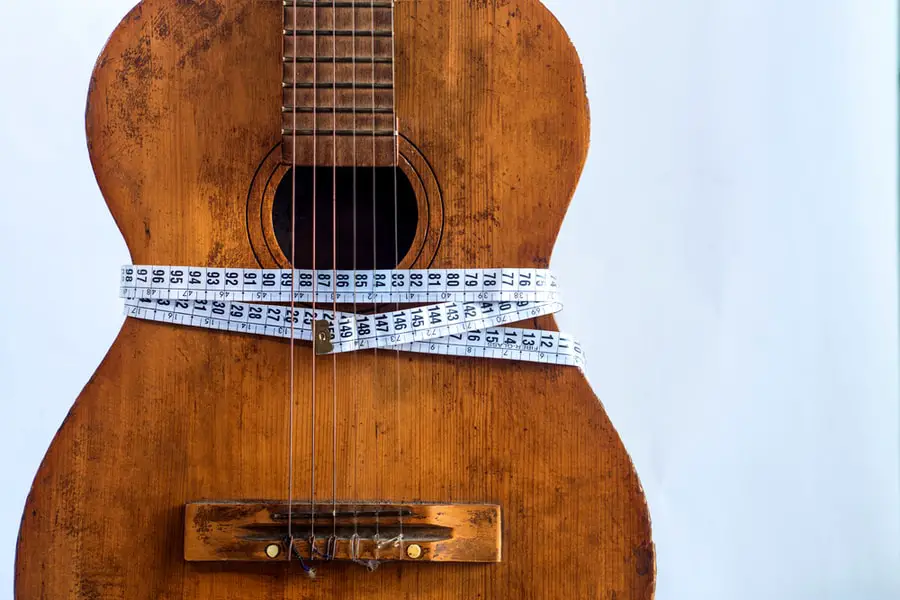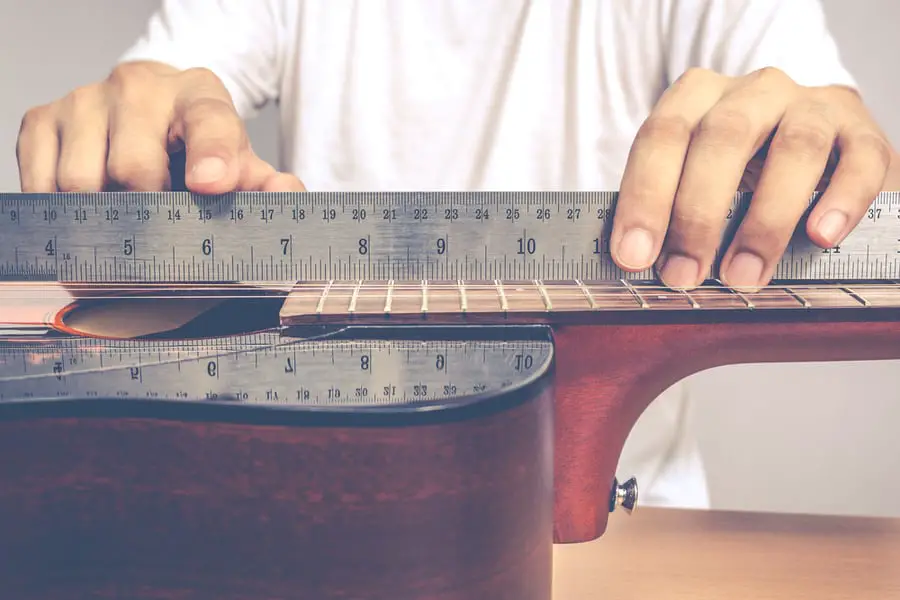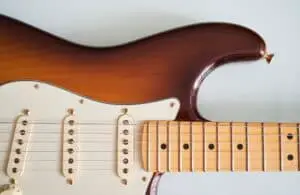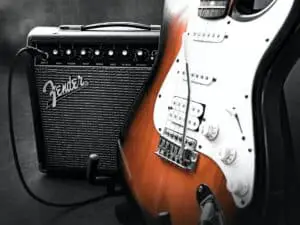
As a musician, you know that your instrument is an extension of yourself. You need to be able to trust it completely and feel confident in its ability to perform. That’s why it’s important to know how to measure a guitar to be sure it is the right size and scale for you.
You might think you will pick up a measuring tape and measure from the nut to the bridge, right? Wrong!
To measure the scale length of a guitar, you will need a ruler or a measuring tape. Start with measuring the distance from the base of the nut to the middle of the 12th fret. Multiply the obtained number by 2, and this will be the scale length of your guitar.
The scale length of a guitar is important because it affects the tone and playability of the instrument. A shorter scale length will result in a brighter, more defined sound, while a longer scale length will produce a fuller, deeper sound.
Read on further for a more detailed explanation of scale length, a comparison between short and long-scale guitars, and how the scale length affects the tone and playability of your guitar.
What Is the Scale Length of a Guitar?

The scale is the vibrating length of a string. It is the distance between the nut and the saddle. The nut is the small piece of plastic or bone that sits at the head of the neck, where the strings attach. The saddle is located at the body end of the guitar, where the strings run through.
The scale length affects how easy it is to play in different keys and how big or small the frets are.
A guitar with a shorter scale length (such as a Parlour guitar) will have smaller frets, making it easier to play in higher keys. A guitar with a longer scale length (such as a Dreadnought guitar) will have larger frets, making it easier to play in lower keys.
The scale length also affects the overall tension of the strings and how much they “bend” when you press down on them. A shorter scale length means less string tension and more bend, while a longer scale length means more string tension and less bend.
The average scale length of acoustic guitars is clustered around 25.4–25.5″. While in the case of an electric guitar, it is 24.75-25″, which is slightly less than an acoustic guitar. Bass guitars tend to have scale lengths between 34″ and 36″.
How To Measure the Scale Length of a Guitar

The very first thing you will need to measure the scale length of a guitar will be a ruler or a measuring tape. Start with measuring the distance from the base of the nut to the middle of the 12th fret. Multiply the obtained measurement by a factor of 2, and you will get the scale length of your guitar.
Most people measure the scale length from one side of the guitar to the other, but this is not an accurate procedure. If you want to be really precise, you will have to follow the above principle.
Let’s Understand With an Example
You are measuring the scale length of your bass guitar and finding the distance between the nut and the 12th fret with the help of a measuring tape. It comes out to be 17.5″.
Remember what to do next?
You are one step away from knowing the scale length of your bass.
Simply multiply the 17.5 by 2. The answer will be 35″, and it will be the actual and accurate scale length of your bass guitar. It also means you have almost a full-size bass guitar.
Once you know the scale length of a guitar, you can use that information to help set intonation, choose the right strings, or find a good starting point for adjusting action.
Why Would You Need To Measure Scale Length?
Why is this measurement important? If you’re looking to buy a guitar, knowing the scale length can help you find the right size instrument.
Different guitar sizes have different scale lengths, so it’s important to choose one that will be comfortable to play.
| Guitar Sizes | Scale Lengths (approximate) |
|---|---|
| 1/8 | 17″ |
| 1/4 | 19″ |
| 1/2 | 23″ |
| 3/4 | 23″ |
| 7/8 | 24″ |
| 4/4 (Full size) | 25.6″ |
Additionally, if you’re looking to buy a case for your guitar, the scale length will determine what size case you need to get. A case that’s too small won’t be able to properly protect your instrument, while a case that’s too large will be unnecessarily cumbersome to carry around.
Knowing the scale length of your guitar makes sure you’re getting the right-sized case to keep your instrument safe.
Short Scale vs. Long Scale Guitars
If you’re a beginner guitarist, you may wonder what the difference between short-scale and long-scale guitar is. Short-scale guitars have a scale length of less than 25.4″, while any guitar having a scale length greater than 25.4″ will be considered a long-scale guitar.
- Short-scale guitars: (Les Paul) have shorter necks, making them more comfortable to play. The strings are also under less tension. This makes them easier to bend and produce a softer sound.
- Long-scale guitars: (Telecaster) have longer necks, making them less comfortable to play. The strings are under more tension. This makes them harder to bend but produces a louder sound.
Ultimately, the type of guitar you choose will depend on your personal preference. If you’re looking for a richer sound or want to be able to play more complex music, a long-scale guitar is probably your best bet.
Scale Length Affects Feel, Tone & Playability
Anyone who has played the guitar knows that they come in all shapes and sizes. But did you know that the scale length of a guitar can have a significant impact on its feel, tone, and playability?
The scale length is the distance between the nut and the saddle, and it impacts everything from intonation to vibrato. Shorter scale lengths are typically associated with warmer tones, while longer scale lengths produce brighter, more articulate sounds.
As for playability, shorter-scale guitars are usually easier to fret, especially for beginners. However, they can be more prone to buzzing because the strings are under more tension.
The longer scale length of a guitar can make it more difficult to fret the strings and requires more hand strength. However, the added tension results in less buzzing and a higher overall volume.
In the end, it’s up to you to decide what scale length is right for you. If you’re a beginner, a shorter-scale guitar might be the way to go.
Takeaway
Now that you know all there is to know about guitar measurement and scale length, it’s time to put that information into practice. Armed with this knowledge, you should be able to find the perfect guitar for your needs, whether you’re a beginner or a seasoned pro. So get measuring and happy playing!
Frequently Asked Questions
The best way to measure the fretboard radius of your guitar is to use a radius gauge. This tool will help you to accurately compare the string’s height with respect to the fretboard radius. By doing this, you can ensure that your guitar is optimally playable.
Guitar necks vary in width among different models and types. The neck width of Fender electric guitars is usually around 1.65″, whereas Gibson guitars have a little wider neck (1.69″).









